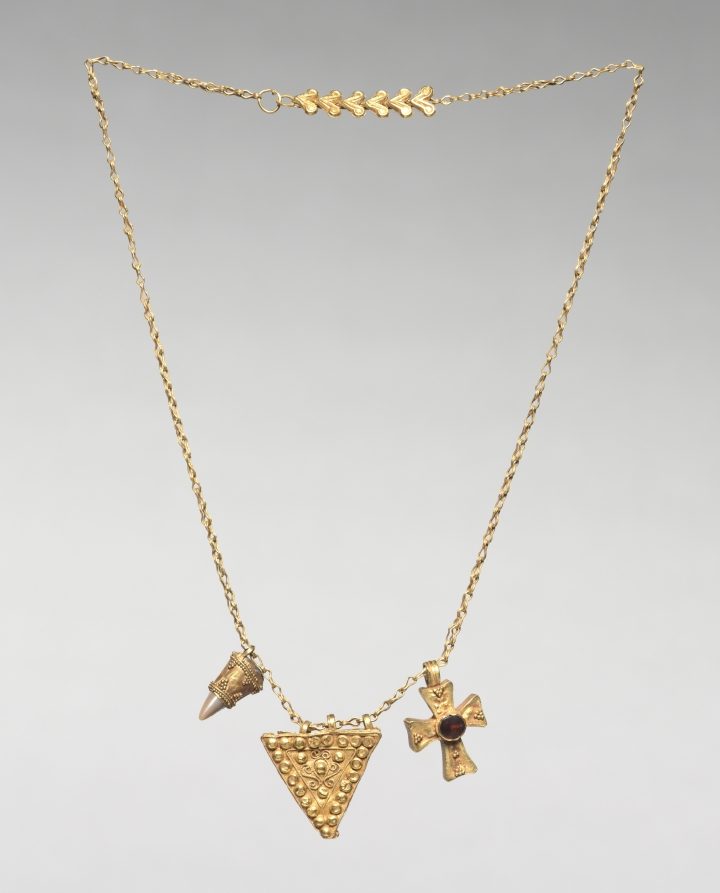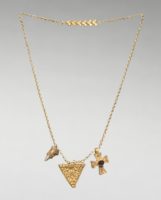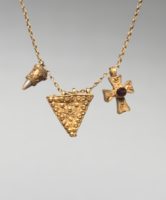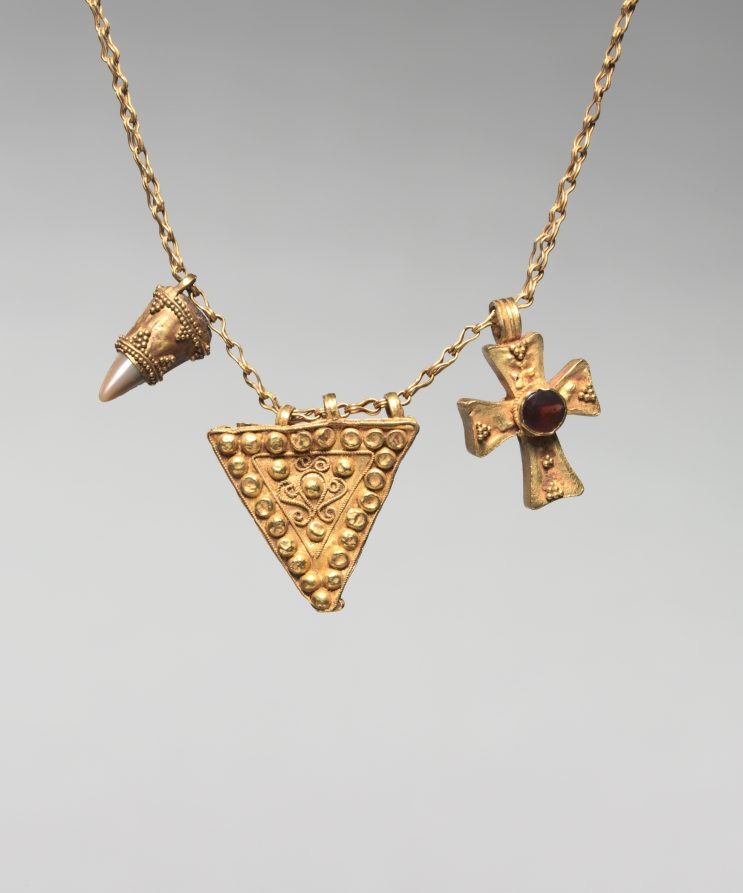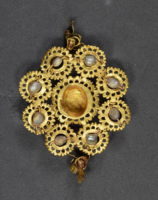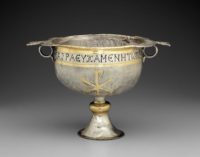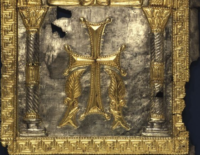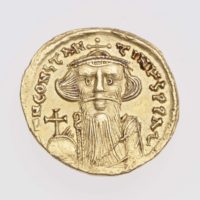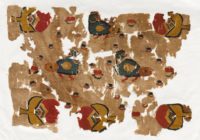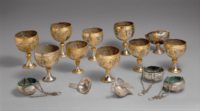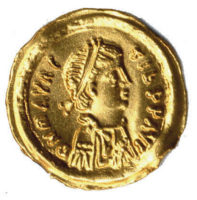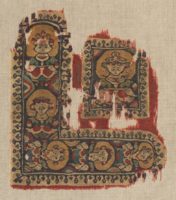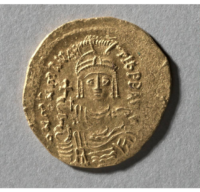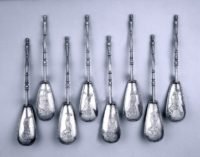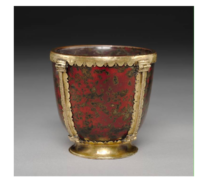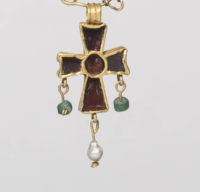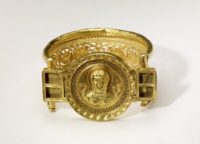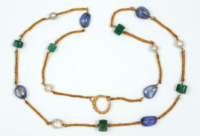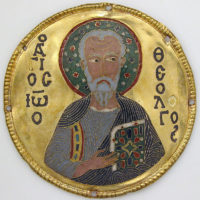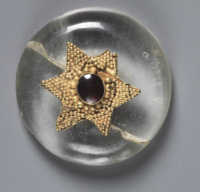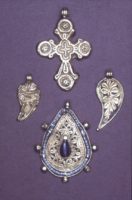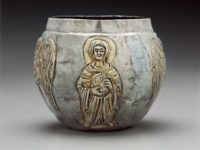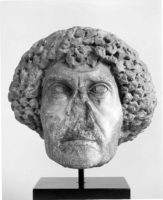Chain with Two Pendants and a Cross, Period: Early Byzantine; circa: 6th century. Type of art work: Jewelry Materials: gold with granulation and a garnet. Overall: h. 45.7 cm (18 in.); Part 1: 2.6 x 2.6 cm (1 x 1 in.); Part 2: 2.8 x 1.9 cm (1 1/16 x 3/4 in.); Part 3: 1.9 x 1.1 cm (3/4 x 7/16 in.). The Cleveland Art Museum Hours: Tuesdays, Thursdays, Saturdays, Sundays 10:00 a.m.–5:00 p.m. Wednesdays, Fridays 10:00 a.m.–9:00 p.m. Closed Mondays.
Pendant; Material: gold. Period: Late Roman; Early Byzantine; (5thc.) Found: Medinet el-Faiyum, Egypt. Open-work; composed of central setting with a stone (now missing), around which are eight small medallions, with a pearl in the middle of each. British Museum is closed 24, 25 and 26 December and 1 January, but is open every other day of the year.
Silver Chalice, Period: Early Byzantine, circa: 6th century A.D. Dimensions: Height (max.): 18 cm. (7 1/16 in.); Width (max. at handles): 26.6 cm (10 1/2 in.); Width (bowl): 16 cm (6 5/16 in.).
The cup has actually ring handles topped by flat plates of lunate kind with trapezoidal forecasts in the line of the handles. An inscribed band in between the manages is flanked by a gilded profiled rim (above) and a gilded profiled band listed below. The body is hemispherical. The high foot includes a concave, then round stem and a cone-shaped assistance with broad, horizontal flange listed below. The niello-inlaid engraving (in Greek uppercase) equates: “Sarah hoped and made [this] using to the First Martyr” (Saint Stephen). Likewise (each side) is a gilded Christogram made up of a chi and rho (the very first 2 letters of Christ’s name in Greek) flanked by alpha and Omega. These are the first and last letters of the Greek alphabet, symbolizing that Christ is the beginning and end of all things. Locations of the bowl are completed; foot is corrected and repaired.
The MFA is open 7 days a week. Monday and Tuesday 10 am–5 pm, Wednesday–Friday 10 am–10 pm, Saturday and Sunday 10 am–5 pm.
Book Cover with a Cross Flanked by Cypress Trees, Period: Early Byzantine, circa: Mid 6th Century. The museum is open to the public Tuesday through Sunday, 11:30 a.m.–5:30 p.m., except for federal holidays.
Solidus of Constantinus III, Mint: Constantinople, Period: A.D. 641–668, Early Byzantine. Material: Gold. The MFA is open 7 days a week. Monday and Tuesday 10 am–5 pm, Wednesday–Friday 10 am–10 pm, Saturday and Sunday 10 am–5 pm.
Fragment of a Curtain, Period: Early Byzantine circa: 500s. Made in: Egypt, Materials: tabby weave, inwoven tapestry ornament; wool and linen, Overall: 38 x 52.3 cm (14 15/16 x 20 9/16 in.). The Cleveland Art Museum Hours: Tuesdays, Thursdays, Saturdays, Sundays 10:00 a.m.–5:00 p.m. Wednesdays, Fridays 10:00 a.m.–9:00 p.m. Closed Mondays.
The Attarouthi Treasure, Period: Early Byzantine, circa: 500-650s. Made in Attarouthi, Syria. Materials: Silver, silver-gilt. On view at The Met Fifth Avenue in Gallery 300.
These well-wrought liturgical items– chalices, censers, a filter, and also a depiction of the dove of the Holy Spirit– were amongst the belongings of a Christian church in the wealthy seller city of Attarouthi in Syria, after that among the wealthiest lands of the Byzantine Empire. The chalices, censers, and also filter were made use of for the Divine Liturgy, or Eucharist, where Christians take consecrated wine and bread in ceremony of the Last Supper and also Christ’s death. According to their inscriptions, written in Greek with several spelling variants, many of the objects were offerings of local citizens to the major church of the town, which was dedicated to Saint Stephen, and to a smaller church dedicated to Saint John (probably Saint John the Forerunner [the Baptist]). In the very early 7th century Syria dropped initially to the Sasanian Persians and afterwards to the militaries of Islam. These works were most likely hidden in haste in a safety container at some minute when the Byzantine military was pulling away from strikes on the area.
The Metropolitan Museum of Art (New York) is one of the world’s largest and finest art museums. Its collection includes more than two million works of art spanning five thousand years of world culture, from prehistory to the present and from every part of the globe. Public Hours: 10:30 a.m.–5:30 p.m. Open seven days a week.
[xyz-ihs snippet="Met-Museum-Booking"]Tremissis of Emperor Maurice Tiberius, Period: ca. 582–602, Early Byzantine, Material: Gold. On view at The Met Fifth Avenue in Gallery 301. The Metropolitan Museum of Art (New York) is one of the world’s largest and finest art museums. Its collection includes more than two million works of art spanning five thousand years of world culture, from prehistory to the present and from every part of the globe. Public Hours: 10:30 a.m.–5:30 p.m. Open seven days a week.
Ornament (Gammadion and Segmentum) from a Tunic, Period: Early Byzantine; circa: 6th century. Materials: tabby ground, inwoven tapestry ornament; wool. The Cleveland Art Museum Hours: Tuesdays, Thursdays, Saturdays, Sundays 10:00 a.m.–5:00 p.m. Wednesdays, Fridays 10:00 a.m.–9:00 p.m. Closed Mondays.
Solidus of Maurice Tiberius, 583-602, Material: gold, Diameter: w. 2.2 cm (13/16 in.). The Cleveland Art Museum Hours: Tuesdays, Thursdays, Saturdays, Sundays 10:00 a.m.–5:00 p.m. Wednesdays, Fridays 10:00 a.m.–9:00 p.m. Closed Mondays.
Silver spoon, Period: Early Byzantine; 650 (circa). Found: Acheripoetos Monastery, monastery (near)(Europe,Cyprus,Nicosia (district),Kyrenia,Acheripoetos Monastery) British Museum is closed 24, 25 and 26 December and 1 January, but is open every other day of the year. Fast facts about the British Museum: Founded: 1753, Collection size: 8 million objects, Oldest object in the collection: Stone chopping tool (nearly 2 million years old).
Calyx (Chalice), Period: Middle Byzantine, 900s-1000s. Blood jasper (heliotrope) with gilt-copper mounts. The Cleveland Art Museum Hours: Tuesdays, Thursdays, Saturdays, Sundays 10:00 a.m.–5:00 p.m. Wednesdays, Fridays 10:00 a.m.–9:00 p.m. Closed Mondays.
Chain with Pendant Cross, Materials: gold, glass, pearl, garnet, and sapphire. Period: Early Byzantine, circa 500s. The Cleveland Art Museum Hours: Tuesdays, Thursdays, Saturdays, Sundays 10:00 a.m.–5:00 p.m. Wednesdays, Fridays 10:00 a.m.–9:00 p.m. Closed Mondays.
Gold Bracelet, Period: Early Byzantine 600 (circa). Found: Syria (?). Width: 69.5 millimetres Height: 43.5 millimetres (medallion) Depth: 64.5 millimetres Weight: 68.57 grammes. British Museum is closed 24, 25 and 26 December and 1 January, but is open every other day of the year. Fast facts about the British Museum: Founded: 1753, Collection size: 8 million objects, Oldest object in the collection: Stone chopping tool (nearly 2 million years old).
Necklace. Materials: Pearls, Sapphires, Gold, Gems and Plasma. Period: Early Byzantine, circa: early 5th century. The museum is open to the public Tuesday through Sunday, 11:30 a.m.–5:30 p.m., except for federal holidays.
Medallion with Saint John the Evangelist from an Icon Frame, Period: Middle Byzantine, circa: 1100, Made in Constantinople, Materials: Gold, silver, and enamel worked in cloisonné. On view at The Met Fifth Avenue in Gallery 303. The Metropolitan Museum of Art (New York) is one of the world’s largest and finest art museums. Its collection includes more than two million works of art spanning five thousand years of world culture, from prehistory to the present and from every part of the globe. Public Hours: 10:30 a.m.–5:30 p.m. Open seven days a week.
Double-sided circular jewellery attachment. Christ Pantokrator is depicted on one side and the Virgin Orans on the other side. Period: Late Byzantine; circa: early 12th century. Dimensions: 0,026 m. The Benaki Museum of Greek Culture is housed in one of the most beautiful neoclassical-style buildings in Athens, near the National Garden and the Hellenic Parliament. It was converted into a museum in order to shelter the collections of Antonis Benakis and was donated to the Greek nation by himself and his three sisters, Alexandra, Penelope and Argine. Following its most recent refurbishment (1989–2000), the building houses a unique exhibition on Greek culture arranged diachronically from prehistory to the 20th century.
Button, Early Byzantine circa: 500s. Materials: Rock crystal with a garnet mounted in a gold granulated star. The Cleveland Art Museum Hours: Tuesdays, Thursdays, Saturdays, Sundays 10:00 a.m.–5:00 p.m. Wednesdays, Fridays 10:00 a.m.–9:00 p.m. Closed Mondays.
Pendant; material: gold; hollow box building; in the form of a bent leaf; obverse chased and convex marked, butt-soldered to a simple opposite; suspension loophole of triple-ribbed strip, the angle in between the loophole and the obverse masked by a brief length of the very same strip. Height: 32.2 millimetres Width: 15.5 millimetres. Period: Early Byzantine. British Museum is closed 24, 25 and 26 December and 1 January, but is open every other day of the year. Fast facts about the British Museum: Founded: 1753, Collection size: 8 million objects, Oldest object in the collection: Stone chopping tool (nearly 2 million years old).
Spherical Small Container (pyxis) with Representations of Christ, Virgin and two Archangels. Period: Early Byzantine, circa: 6th–7th century A.D. Dimensions: Height x diameter: 7 x 9 cm (2 3/4 x 3 9/16 in.). Materials: Silver with gilding. This gilded silver pyxis of round kind was a container for antiques or scent made use of in Early Byzantine church ceremonies. The 4 figures created in repousse method reveal a bearded Christ offering a true blessing, the Virgin holding a symbol symbolic of her duties as Mother of God (Theotokos), as well as 2 angels worn lengthy sleeved chitons with segmenta on their shoulders and also hems. The cover is shed however could have had a dedicatory inscription.
The MFA is open 7 days a week. Monday and Tuesday 10 am–5 pm, Wednesday–Friday 10 am–10 pm, Saturday and Sunday 10 am–5 pm.
Portrait of an official, Period: Early Byzantine Period, circa: Late 5th–early 6th century A.D. Dimensions: Height: 21 cm (8 1/4 in.). Material: Marble. Found: Göktepe near Aphrodisias Ancient City, Anatolia (Modern Turkey). The MFA is open 7 days a week. Monday and Tuesday 10 am–5 pm, Wednesday–Friday 10 am–10 pm, Saturday and Sunday 10 am–5 pm.


